Recent Storm Damage Posts
Why relationships matter during a storm
8/31/2023 (Permalink)
As of the time of writing, the last major storm that hit Western New York was Winter Storm Elliott over the holiday season in 2022.
Elliott was a game-changer for many - the high winds mixed with the freezing temperatures and the massive snowfall created a "perfect storm" situation for property damage to go from bad to worse.
In these situations, the level of need for SERVPRO's services is through the roof. And it's in these situations exactly that relationships really matter.
Our premier partners with whom we have formal service agreements were able to get the help they needed immediately, without any need to procure insurance certificates, go over protocols or delay service for administrative reasons.
We implore all commercial real estate professionals to form a relationship like this with a restorer. You never know when you'll need it.
What is roof tarping after storm damage?
8/5/2022 (Permalink)
Imagine: the big one hits. A gigantic thunderstorm (or, more likely in Western New York, a historic blizzard) blows through town and wreaks havoc on your neighborhood.
You're fast asleep when you hear an enormous crashing sound coming from above you.
Uh-oh. The limb of a nearby tree has decided to finally give out and crash into your roof, punching a hole in the top of your house.
What do you do?
Obviously, you'll need to clear the limb. But once that work is complete, you've still got issues on your hands. Your roof has been compromised and your house is now exposed to the elements, including snow, rain, ice and wildlife.
Getting a roofer out to fix the problem could take days, if not weeks, especially if the weather's bad.
That's where emergency roof tarping comes in. Tarping your roof is a temporary fix that prevents additional secondary damage after an initial damage event.
If you've had damage to your roof, don't wait - call for a tarp-up before it gets any worse.
How dangerous is wind in a storm?
8/5/2022 (Permalink)
Your home was built to stand up to the elements for a long, long time. Especially here in Western New York, it's not uncommon for people to live in homes that are over a century old and still in excellent condition.
That said, your house is not invulnerable when big storms roll through the region. And one of the most dangerous elements of those storms is invisible to the naked eye: high winds.
For the most part, wind itself isn't dangerous to a structure. Your house might creak and groan, but it's not going to get blown over.
Wind damage usually comes from other debris blowing around. A rotting tree, dead branch or even a few pieces of gravel propelled by abnormally high winds can harm you as well as your property.
How can you protect your home? Clear this debris so that it doesn't pose a threat, maintain your home well, and hope for the best.
Why is it important to pick up debris after a storm?
8/5/2022 (Permalink)
Storms of all types can wreak havoc on your property in all kinds of way.
Flooding and water damage are urgent problems that must be dealt with immediately. Lightning strikes can lead to trees falling and fires starting.
These are massive, flashy problems that most people are aware of. Not as many people are aware of the risks that something as simple as storm debris can pose, though.
After all, picking up debris is a chore, and it's your yard anyway, right?
Maybe so, but that debris can be deadly in the wrong conditions.
Storms typically bring high winds along with them. These high winds, on their own, generally don't pose too much of a threat to a person or their property.
But when these winds pick up debris, like rotting or fallen trees or even displaced gravel, things can get serious quickly. These forms of debris become projectiles.
So after a storm, and especially before a storm, make sure you clear your property!
What can a storm do to your roof?
8/5/2022 (Permalink)
Storms can be incredibly damaging events for homes throughout the Western New York region, and one of the major flash points for damage is the roof.
Your roof is built to withstand the elements on a routine basis. But a storm is anything but routine. High winds, huge volumes of precipitation and falling debris can all cause serious damage to your roof.
After a storm, you should keep a look out for common forms of damage.
Water stains, for instance, can begin to form on your ceiling and are sometimes the first indication that your roof has been damaged and begun to leak. If they show up quickly, that means that the leak is probably pretty serious and you need to deal with it right away.
Shingles are also a telltale indicator of roof damage. If you notice missing or loose shingles, you've obviously got a problem. But even discoloration can be a sign of an issue, as it often indicates damage from hail or debris.
What is wind and hail insurance?
8/4/2022 (Permalink)
In the United States, the most common and frequent homeowners claim is not simple water damage: it's wind and hail coverage.
Here in Western New York, you might find that surprising. While we definitely have strong winds, we don't see much hail, and you don't often see people putting in claims for wind and hail.
So what is wind and hail insurance? And why are these claims so frequent?
Wind and hail insurance can go by many names: windstorm insurance, hurricane insurance and even tornado insurance.
Much like flood insurance, it is usually a separate type of coverage distinct from your run-of-the-mill homeowners policy.
But if you live on or near a coast, wind and hail coverage is a necessity. It may even be required as a stipulation to getting a mortgage.
After all, imagine if you didn't have wind and hail coverage and a major hurricane blew through. Your entire home could be destroyed, and you could be left paying the bill out of pocket.
What if a storm makes your roof leak?
8/4/2022 (Permalink)
Roof leaks can range from minor annoyances to major hazards.
When they aren't that serious in the moment, though, many people are tempted to ignore them. Why worry about about a roof that only leaks once or twice per year?
The truth is that roof leaks can lead to all kinds of problems that can affect you long after the initial rainfall ends.
Mold is a prime example. If water infiltrates your home after a minor roof leak, it doesn't just go away. It can become the X factor that leads to serious mold and microbial growth which might be hidden behind walls.
Wood rot can also set in. The wood inside your home, like your framing, is not treated the same way that outdoor wood is and is not meant to get wet. Over time, if it gets wet, it can begin to rot and lose integrity.
So if you have a roof leak, don't write it off - dry out your home and get the leak fixed ASAP.
Is Bathing During a Thunderstorm Safe?
7/16/2021 (Permalink)
Did your mother used to tell you that you should avoid bathing or showering during a lightning storm because there was a chance that you could get electrocuted?
As a child, this kind of warning was terrifying. As an adult, it has the ring of an old wives’ tale. But is there any truth to it?
As it turns out, yes: there’s a real possibility that you could be electrocuted if you take a shower during an electrical storm. Our source? The New York Times: https://www.nytimes.com/2006/08/15/health/15real.html
As the NYT writes, and as every graduate of fourth-grade science class knows, both metal pipes and water are extremely conductive of electricity. While your house was likely built with some kind of mechanism for channeling the electricity from a lightning strike into the ground, it’s not always perfect. According to Ron Holle of NOAA, between 10 and 20 people every year get electrocuted while bathing, using faucets or handling appliances during storms.
So if you take a shower, is it likely that you’ll be electrocuted? Probably not. But there is a chance.
Why is Flood Water Considered to be Category 3?
7/16/2021 (Permalink)
In water damage restoration, we use different categories as a shorthand to assess the level of contamination in the water that we encounter. Category 1 water is relatively clean (e.g. a water supply line); Category 2 water is significantly contaminated (e.g. a dishwasher leak); and Category 3 water is grossly contaminated (e.g. sewage).
Many people are surprised to find out that flood water is considered to be Category 3. In their minds, flood water either came from heavy rains or from a nearby body of water. While you might not want to drink the water from your local creek, it hardly seems like it should be considered to be “grossly contaminated.”
With flood water, this categorization usually stems less from the source of the water and more from what the water picked up on the way. You have no idea what kind of sediment, pathogens or contamination that the water encountered before it made its way into your structure. Since the water is likely full of hitchhiking contaminants, we consider it to be Category 3 and treat it accordingly.
What Makes Something a Flash Flood?
7/16/2021 (Permalink)
The weather report often gets a bad rap for being unreliable and imprecise. The meteorologists on TV might call for rain and get sunshine, or vice versa, and all of a sudden people start to discount everything that they say.
While the science of predicting the weather can sometimes be a probabilistic guessing game, the language that we use to describe particular weather events is usually very, very precise.
Take the difference between a “flood” and a “flash flood.” You probably have a vague grasp of what separates the two, but could you put it into writing?
A flood is defined by the National Weather Service as “an overflow of water onto normally dry land.” Water levels rise in existing waterways because of precipitation, and floods spill out and cause trouble.
Flash floods, meanwhile, are tied to a timeline: six hours. If the rainfall that caused the flooding occurred in a six-hour timespan, and the flooding was nearly immediate, then it’s a flash flood. Actually, flash floods can be declared even if no rain has fallen so long as there’s an influx of water, as in a dam or a levee breaking.
What to Do During a Flood Watch or Warning
7/16/2021 (Permalink)
Floods can be extremely dangerous events. Not only are the waters themselves capable of causing enormous amounts of damage and loss of life, but the water itself is often contaminated with infectious disease and chemical hazards.
If there’s a flood watch or warning happening in your area, it’s important for you to spring into action immediately to prepare for the worst. The CDC recommends doing the following during a flood watch:
- Gather up your emergency kit (and if you don’t already have one, make one!);
- Stay tuned to local updates on TV. If the power’s out, use a self-powered radio to monitor.
- Build up a supply of clean water. You may want to consider filling your bathtub, sink and any clean plastic/glass bottles that you have as well. Sinks should be well-sanitized before being filled.
- If you keep anything outside (like patio furniture or your grill), bring it in or tie it down.
- If you have to evacuate, turn off your utilities and close your gas valve.
- Follow evacuation instructions exactly. Even if there is no evacuation order in place, consider leaving if you are in a particularly vulnerable location (e.g. somewhere at a low elevation).
By following these tips, you’ll be prepared in case the worst happens.
Returning Home After a Flood
7/16/2021 (Permalink)
If your home or business has suffered flood damage, then it is incredibly important to react intelligently and safely. Even if the standing water itself has dissipated, there still may be serious threats to your and your family’s health lurking where you’d least expect. Even returning from the evacuation point can be dangerous.
To the greatest extent possible, you should avoid coming into contact with flood water. Definitely do not use it as an alternative to regular water, even if you’re just using it to quickly rinse your hands off. Flood water can contain contaminants and pathogens that can cause health effects.
Do not return to your home until you’ve been cleared to do so. It can be tempting to come home as soon as possible, but you should follow the instructions of your local authorities to the letter.
If you’re traveling, avoid driving through standing water. Even levels as low as six inches can cause you to lose control of your vehicle.
If you follow these tips, you should be able to return to your home safely.
Cleaning Your Home After a Flood
7/16/2021 (Permalink)
Imagine that you and your family have been forced to evacuate because of a flash flood in your area. You rush to the evacuation shelter, wait it out, and get the all clear to return home. Your worries are over, right?
Wrong. If your home has been affected by flood waters, there are still serious health effects that you need to be aware of as things get back to normal.
A good mantra is “when in doubt, throw it out.” If any of your food or water has come into contact with flood water, even if it’s in a container (like bottled water), you should toss it out.
Similarly, any drywall, carpets or insulation that have been contaminated with flood water should be thrown away as well. This practice is consistent with the IICRC’s Standard of Care.
Any porous belongings should also be tossed. Things like mattresses, pillows and even stuffed animals cannot be properly sanitized after coming into contact with flood water and should be thrown away.
Non-porous materials, on the other hand, may be able to be cleaned with household bleach. Make sure you dilute the bleach to the proper concentration before using it.
Remember: flood water is generally considered to be “grossly contaminated” with pathogens, on the same level as sewage. Treat it with extreme caution.
How to Use a Generator Safely During a Storm
7/9/2020 (Permalink)
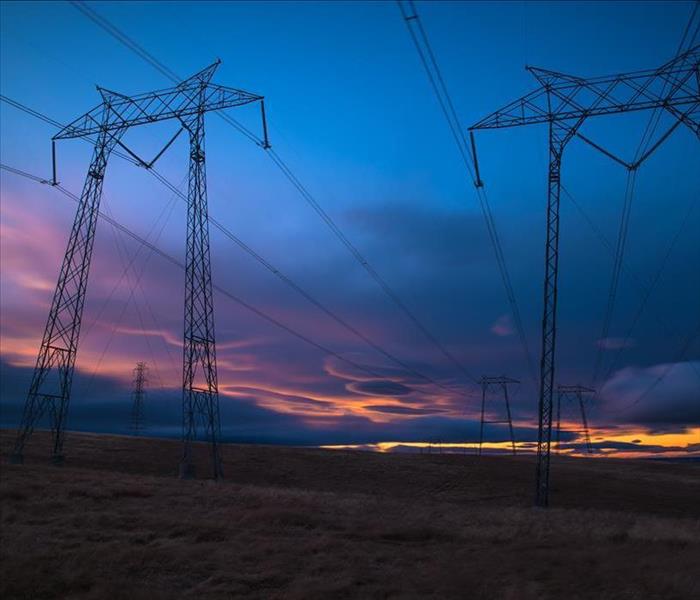 Are you prepared for a power outage?
Are you prepared for a power outage?
Western New York isn’t exactly Tornado Alley, but we’ve dealt with our fair share of severe thunderstorms this summer, and we can be certain that we’ll see plenty of punishing blizzards when winter finally rolls back around.
For this reason, it’s vital that you and your family are prepared for the worst, including prolonged power outages at your home. One tool that many find essential is the portable generator.
Portable generators allow you to power electronics even when your electricity has been knocked out by storm damage. While some families find them to be a luxury, others rely on generators to get them through power outages safely and sanely.
If you do invest in a generator, keep the following safety tips in mind:
- Many portable generators are powered by gas, which comes with a special set of risks and hazards. Never use your generator (and for that matter, any grill, camp stove or other gas/propane/charcoal powered device) inside your home, garage, basement, crawl space or location that is partially enclosed.
- Generators also carry the risk of electrocution, and that risk can be exponentially greater in a storm situation where there’s an increased risk of flood. Keep your generator dry and do not use it in wet conditions under any circumstance. Keep it under an open canopy (like a tarp held up on poles). Definitely avoid touching the generator if your hands are wet.
- Finally: even if you’re operating the generator according to these safety guidelines, there are still risks you need to protect yourself from, like carbon monoxide. If you plan to use a generator, make sure that there are carbon monoxide alarms on every level of your property, as well as outside sleeping areas, to ensure early warning if anything goes wrong.
Generators are great tools to have in a storm situation – just make sure you can use them safely. And if you’re dealing with any storm damage or flooding, give us a call at SERVPRO of West Seneca/Lancaster at 716-674-1103 – we’re here to help!
7 Tips for Winter Storm Prep in Western New York
7/9/2020 (Permalink)
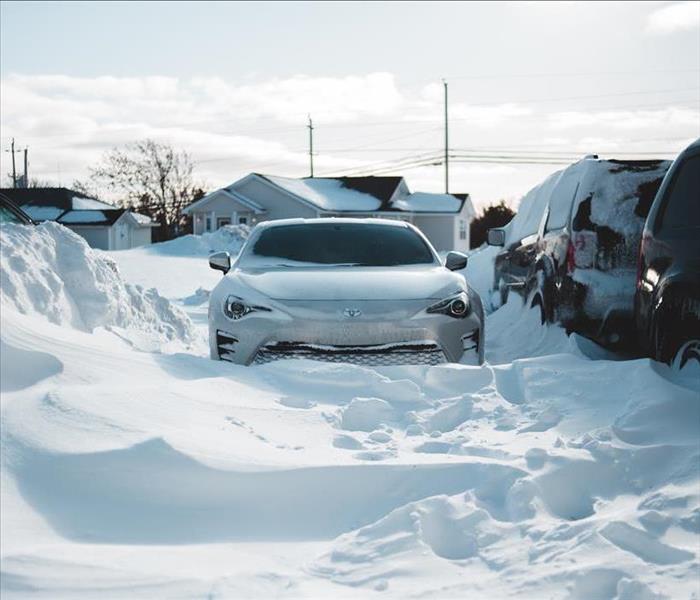 Don't let this happen to you.
Don't let this happen to you.
Western New York is famous for its snowfall, and while every winter won’t have a “Blizzard of ’77” moment, you can be reasonably sure that we’ll have at least a handful of disruptive snowstorms every year.
With that in mind, then, preparing for a severe snowstorm isn’t about preparing for something that might happen – it’s about preparing for something that will happen.
With that in mind, the team here at SERVPRO of West Seneca/Lancaster came up with seven tips to help you to prep for any winter storm that comes your way.
- Have an open conversation with your family about what to do if a winter storm watch or warning comes out. Should everyone come home and hunker down? Planning is especially important if you have teenage children who may not be home or easily accessible when weather alerts are issued.
- Winterize your vehicle when cold weather rolls around to reduce your risk of being stranded.
- You should also check your vehicle’s battery, antifreeze, lights, hazards, oil, wipers and wiper fluid. Employ a professional to check other systems, like the ignition, exhaust, thermostat, heat, brakes and defroster.
- Keep an emergency supply kit in your car which includes a scraper, a small broom, waterproof matches, warm clothing, blankets and anything else you might need if stranded.
- Keep your gas tank full at all times.
- Keep your phone charged at all times.
- Even if you’re just running out of the house, wear a warm coat, gloves and hat in case you get stuck or stranded.
You might like the snow, but no one likes to deal with the problems associated with a blizzard. Follow these seven tips to stay safe and call SERVPRO of West Seneca/Lancaster if you need us – we’re here to help!
Lightning Safety in Western New York
7/9/2020 (Permalink)
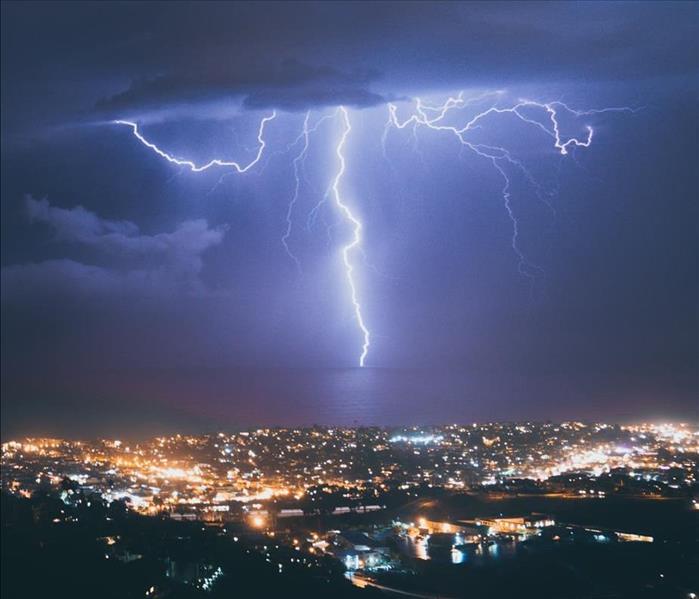 Cool? Yes. Dangerous? Very.
Cool? Yes. Dangerous? Very.
Lightning can be pretty cool to watch, and an all-out electrical storm is downright breathtaking. But just because you like to watch thunderstorms roll into Western New York doesn’t mean that you should throw caution to the wind. Lightning strikes about 51 people per year, according to the National Oceanic and Atmospheric Administration, and you don’t want to be one of them.
The easiest way to avoid lightning is simply to stay inside during a storm. However, if you absolutely need to go outside during a thunderstorm, consider the following.
Staying Safe Outdoors During Lightning Strikes
If you hear thunder, you really should go indoors, or at least get under a safe, enclosed shelter. Use the 30-30 rule to judge how much you have to rush. Once you see lightning, start counting to 30 – if you hear thunder before you hit 30, hightail it indoors and wait until 30 minutes after you hear the final clap of thunder to go back outside.
Can’t find indoor shelter? You can still try to be safe. Crouch low with as little of your body touching the ground as possible, as electrical currents can travel over 100 feet through the surface of the ground.
Staying Safe Indoors During Lightning Strikes
Even if you get inside, you’re not necessarily safe during a serious lightning storm.
Stay away from water during a severe thunderstorm, as lightning can travel through plumbing. Avoid electronics as well – lightning can also travel through electrical systems, and even through corded phones.
Avoid concrete floors and walls as well. They contain metal wires and bars that can conduct electricity towards you.
If your home or business is damaged during a thunderstorm, don’t hesitate to call SERVPRO of West Seneca/Lancaster at 716-674-1103 – we’re here to help!
Cleaning Contaminated Floodwater Damage After a Storm
7/9/2020 (Permalink)
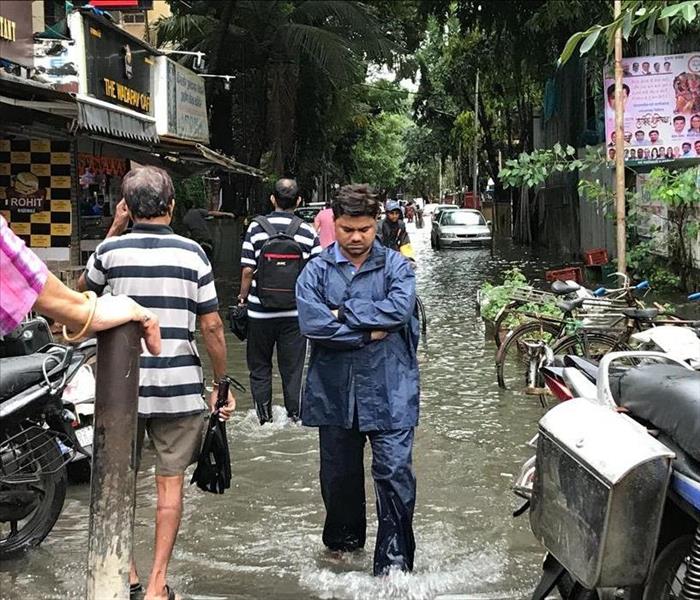 We know how you feel. Floods are no fun.
We know how you feel. Floods are no fun.
Contaminated groundwater, referred to as “category 3,” can devastate a home even more than your average water loss. This contaminated water will destroy anything that absorbs it, and that damage will get exponentially worse the longer it takes you to get rid of it. Often, this type of water gets into the home during a storm, when water is liable to flood into your property, especially your basement.
But what’s so bad about flood water? What kind of damage can it cause? And how do you get rid of it? We’ll tell you.
What’s so bad about groundwater in a flood?
The worst thing about the water that flows into your property during a flood isn’t the water – it’s what the water brings with it. Rushing waters pick up all sorts of contaminants on their way to your home or business. These contaminants include the obvious, like mud and debris, but can also include viral pathogens, toxins and even sewage that has backed up out of drains. You don’t want any of these things flowing into your property.
What’s worse, water has a tendency to spread far beyond the initial point of entry. Water can be absorbed in all kinds of hard-to-reach places, like under tile, behind baseboards, and deep into carpet and subflooring. This tendency is especially harmful because once that water enters your home, the clock starts to tick. The faster you can get that water out and off of your floors, the less damage there will be. SERVPRO techs excel at completely extracting water and drying affected materials, even in the hard-to-find areas.
How do you clean and restore groundwater damage?
Since groundwater is often contaminated, our technicians often wear protective clothing, eye protections and respirators to keep pathogens from being ingested or inhaled. In some cases, they may also apply certain treatments before the mitigation process begins for maximum safety.
We often begin the process with controlled demolition. Porous materials that are contaminated are difficult to sanitize completely, meaning that it’s often more affordable and more efficient to tear them out and focus on reconstruction.
The amount of demolition depends on the material. With sheetrock and drywall, for instance, our technicians often have to cut in several inches above the waterline to both remove any damaged material and open up the cavity of the wall for drying.
Grouted, sealed ceramic tile, meanwhile, usually fares better, since it can keep out much of the contaminated groundwater. Adhesive tiles, meanwhile, may not be so lucky, though we can often remove, clean and reuse those tiles to save home and business owners money.
Contaminated carpets fare worse. Saturated carpet can almost never be sanitized to an acceptable level for reuse and is usually cut out and disposed of as a biohazard. Anything that is disposed of is documented for insurance purposes.
Once demolition has been completed, drying can begin. Assuming that tile and carpet has been removed, our team will then focus on drying the subfloor completely while it is exposed. Usually, this entails the use of drying mats, forced air flow, Injecti-Dry systems and other industry-leading techniques to completely dry the subfloor before tile and carpet is reinstalled and reconstruction begins in earnest.
But it’s not just your structure that can be contaminated by groundwater. Your possessions can be exposed to dirty floodwater as well, with mixed results. Anything that’s porous will likely need to be disposed of, as it will not be able to be acceptably sanitized. Non-porous items, meanwhile, especially those that can be subjected to immersion cleaning, more often have positive outcomes. Our array of proprietary cleaning agents, biocides, and antimicrobial solutions help us to achieve the best outcomes possible for our customers.
Dealing with a flood or water loss yourself after a storm? We’re here to help. Call SERVPRO of West Seneca/Lancaster at 716-674-1103 when you need us!
7 Steps to Take After a Storm Damages Your Home
7/9/2020 (Permalink)
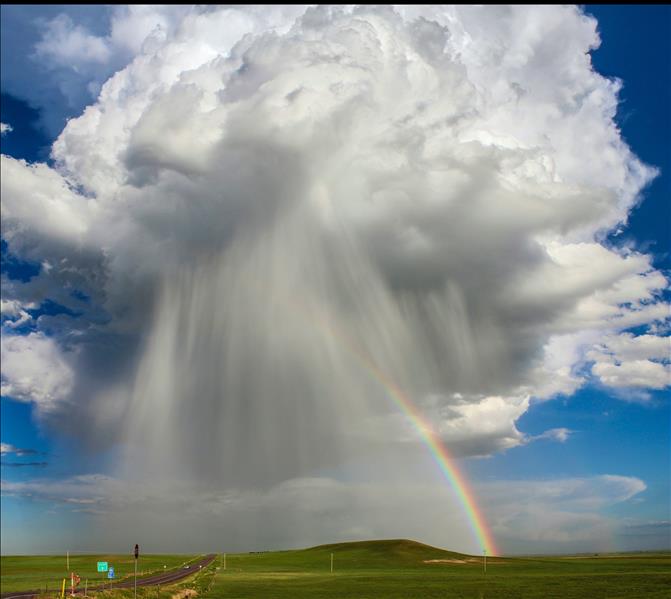 Storms can be pretty cool, until they cause damage.
Storms can be pretty cool, until they cause damage.
Severe thunderstorms, along with blizzards, are a perennial concern here in Western New York. They bring enormous amounts of precipitation along with high winds and hazardous conditions for travel, which in turn can cause serious damage to your home and property.
Has your home been damaged seriously in a storm? Here are six things you should do immediately.
Find somewhere to stay.
If there’s been structural damage to your home, it’s likely not safe to stay there until that damage has been repaired. A few minor issues are one thing, but if you have a collapsing roof, collapsing walls, damaged windows or standing water in your home, you need to find alternative lodging.
Shut off the gas.
If you have any reason to believe that your gas lines have been punctured, shut off the gas ASAP. Usually, you’ll notice a problem when you smell gas pervading your home. Trust your senses – switch the gas off.
If there’s standing water, turn off the electricity if possible.
We all know that water conducts electricity. What you might not realize is that storm damage can expose standing water in your home to electricity without you noticing. If there’s any standing water, avoid stepping in it until you can safely turn your electricity off.
Watch out for dangerous debris.
As you navigate your home, electricity and standing water aren’t the only thing you have to worry about. Watch out for things like broken glass, newly exposed nails any anything else sharp that you might not be expecting.
Take as many photos as you can.
Assuming you can safely move around your home, take as many pictures of the damage as you can. You’ll need them as a record when you speak to your insurance company.
Call your homeowner’s insurance agency.
Call your insurance agent ASAP to inform them of the damage to your home. This will enable them to get the ball rolling on a claim so that you can receive payment ASAP for repairs.
Call the restoration specialists at SERVPRO of West Seneca/Lancaster.
Your insurance agent will agree – getting a restoration company involved as early as possible is the key to not only reversing your storm damage quickly, but keeping costs down as well. Call SERVPRO of West Seneca/Lancaster 24/7/365 at 716-674-1103 – we’re here to help!
Storm Damage in WNY? We're Here to Help!
7/7/2020 (Permalink)
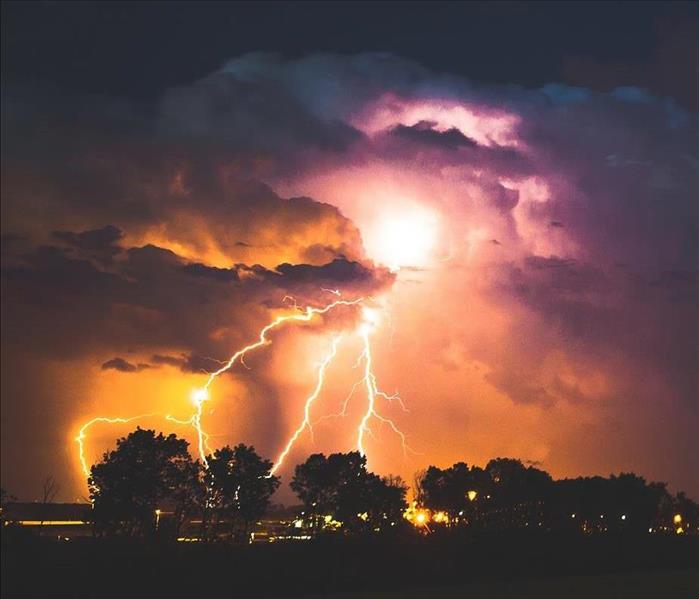 When storms strike, call us.
When storms strike, call us.
In Western New York, we’re no strangers to severe weather. We see crazy thunderstorms in the summer and even crazier blizzards every winter and we take a special pride in our ability to weather any weather that Mother Nature throws at us.
But even if we know that storms are coming, it’s hard to be prepared for serious storm damage. Whether you’re a homeowner or a business owner, we want you to know that when floods, blizzards, hail and storms hit Western New York, we at SERVPRO of West Seneca/Lancaster are here to help, providing the cleaning, restoration and reconstruction you need to minimize damage and get back to normal.
What does SERVPRO of West Seneca/Lancaster do in a storm?
Here’s a quick rundown of how we can help you:
- Emergency service 24/7/365;
- Thorough inspection and damage assessment;
- Removal and extraction of water;
- Drying and dehumidification;
- General cleaning;
- Repair, restoration and reconstruction;
- Carpet and upholstery cleaning;
- Odor removal;
- Disinfection;
- And more!
In short, when it comes to storm damage, we can do it all! Just call 716-674-1103 when you need us.
In the meantime, here’s what you can do until help arrives:
- Mop and blot excess water – the more you can remove, the better;
- Wipe up any excess water on wood furniture as well;
- Remove and prop up wet upholstery and cushions;
- Place foil or wood blocks between furniture legs and wet carpeting;
- Turn on AC in the summer to help with drying;
- Take art, documents and other difficult to replace objects somewhere safe;
- In general, be safe and get everything as dry as you can!
We’re here to help with storm damage 24/7 – call us at 716-674-1103.
Faster To Any Size Disaster!
7/24/2019 (Permalink)
 Here is our Training Supervisor Taylor Braun educating our crew on the latest advances in the restoration industry.
Here is our Training Supervisor Taylor Braun educating our crew on the latest advances in the restoration industry.
When storm time hits here at SERVPRO of West Seneca/Lancaster, we know time is of the essence. It is important for everyone on our crew to be on the same page, and be able to go into action immediately. That is why proper training is a key factor during storm time. Our Training Supervisor Taylor Braun works with our crew every Monday at our weekly meeting, to ensure that they know and understand all the latest restoration techniques.
That way, when storm time hits, they are able to make your water damage, “Like it never even happened.” faster. Our crew understands that in order to accomplish this, they must work efficiently and quickly. Also, because we are a part of the SERVPRO Franchise should we need it, we have access to equipment from over 1,700 other franchises across the United States and Canada.
That really makes us faster to any size disaster. So, if you experience water damage from a severe storm, please call our office at (716) 674-1103 today!
The Right Certifications Matter
7/24/2019 (Permalink)
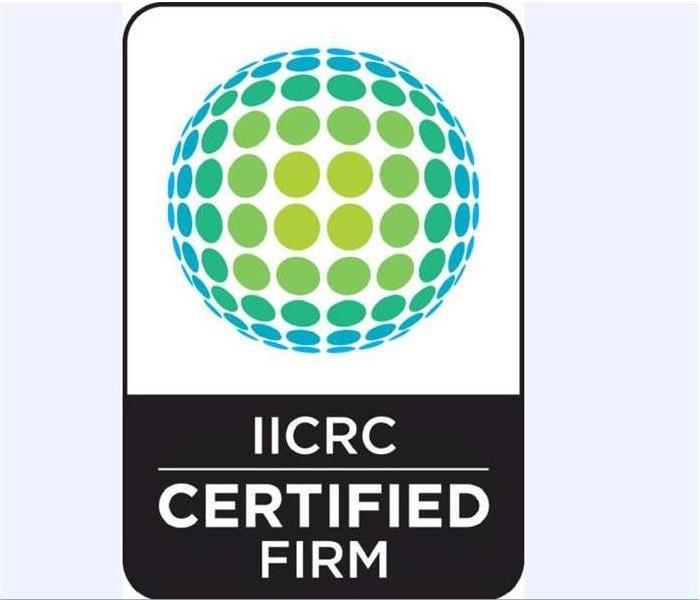 Each one of our professional technicians must obtain, and maintain a IICRC Certification.
Each one of our professional technicians must obtain, and maintain a IICRC Certification.
In order to make sure that we are faster to any size disaster during storm time, all of our technicians must be IICRC certified. The Institute of Inspection, Cleaning and Restoration Certification creates the standards for the restoration industry, as well as provides training and certification to restoration companies. So what does it mean when we say SERVPRO of West Seneca/Lancaster is an IICRC Certified Firm? Well, it means that we must:
- Present accurate information to consumers and conduct business with honesty and integrity.
- Require a technician on all jobs who has been formally trained and passed all required tests.
- Require a continuing education program to keep technicians up to date on the latest changes in the restoration industry.
- Maintain liability insurance to protect all parties in the event of an accident.
- Maintain a written complaint policy and agree to the Better Business Bureau or similar arbitration to resolve disputes, and accept the conclusions and recommendations of arbitration.
The IICRC has set the standards in the restoration industry for years. We are proud to follow the protocols and procedures they have created. Every five years the IICRC reviews and revises their standards, making sure that only the most effective procedures are being used.
Therefore, trust the team at SERVPRO of West Seneca/Lancaster to help you with any water damage caused from a storm.
Emergency Planning: Flooding Edition
7/19/2019 (Permalink)
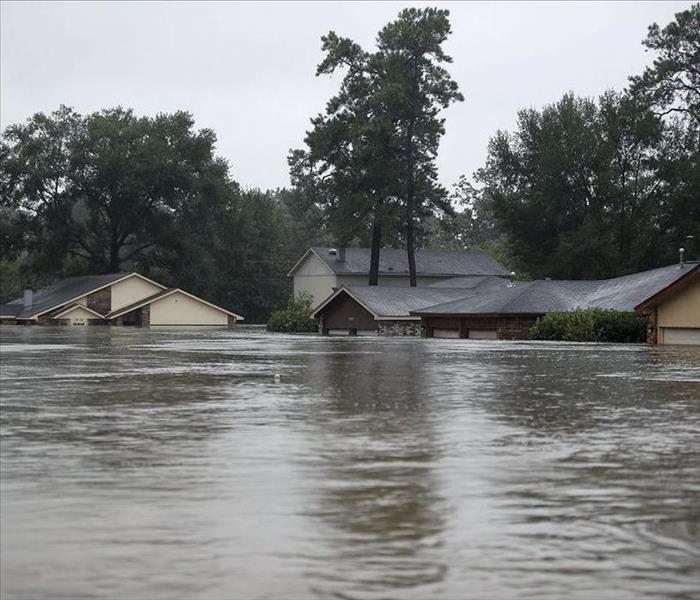 It is important to stay safe during a flood. Follow these action steps to keep you and you're family safe.
It is important to stay safe during a flood. Follow these action steps to keep you and you're family safe.
We’ve talked about why you should never clean up after a flood, but what about what should you do during a flood? Believe it or not, floods are the most common natural disaster in the United States and WNY is not immune to this type of disaster. We have seen flooding all over WNY. From Silver Creek and Gowanda, to West Seneca and South Buffalo, flooding does not discriminate where it will strike.
More recently, we have seen flash flooding in Ellicottville and Little Valley. So, it is important to understand the proper safety precautions you should take during a flood.
According to Ready.gov you:
- Depending on where you are, and the impact and warning time of flooding, go to the safe location that you have previously determined.
- If told to evacuate, do so immediately. Remember to NEVER drive around barriers, they are there to safely direct traffic out of flooded areas.
- Listen to EAS, NOAA Weather Radio, or local alerting systems for current emergency information and instructions.
- Stay off bridges over fast moving water.
- If your vehicle is trapped in rapidly moving water, then stay inside. If water is rising inside the vehicle, then seek refuge on the roof.
- If trapped in a building, then go to its highest level. Do not climb into a closed attic. You may become trapped by rising floodwater. Only go to the roof if necessary. Once you are there, signal for help.
Remember to listen to authorities to determine when it is safe to go home. Never touch electrical equipment when wet, and do not wade in flood waters as there could be snakes, other animals, and dangerous debris floating around. Be sure to check out Ready.gov for more important safety tips and procedures on flooding.
https://www.ready.gov/floods
All Hands On Deck During Storm Season
7/19/2019 (Permalink)
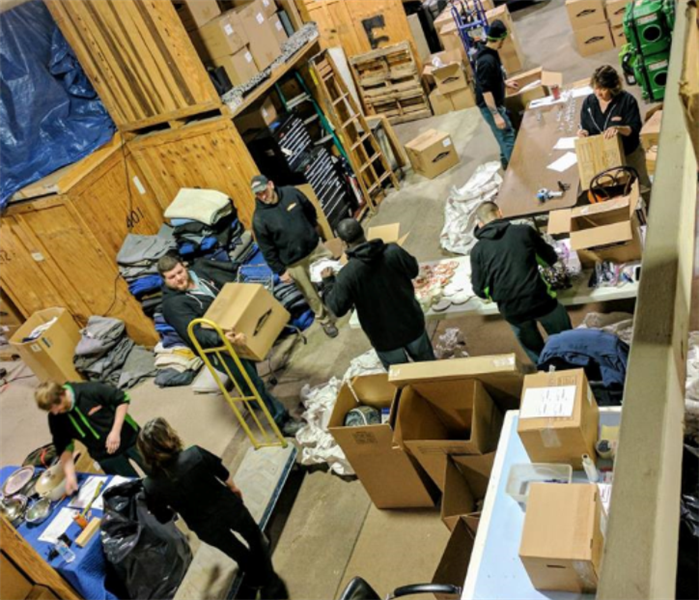 When we say, "all hands on deck" we mean EVERYONE helps out.
When we say, "all hands on deck" we mean EVERYONE helps out.
When a wide spread, severe storm hits our WNY area it is no surprise that we see an influx in calls. Heavy rains can cause sump-pumps to back up or overflow, foundations to leak or several other events that cause significant water damage to your home. So, when storm time hits the Lancaster and West Seneca area it’s all hands on deck here at SERVPRO of West Seneca/Lancaster.
What do we mean when we say, “all hands on deck”? We mean that EVERY ONE in the company is pulled to help. That’s right, from Lyn and Thom Braun (the owner’s), to our Marketing Department of Jocelin and Emily, everyone helps field calls, assist with pack-outs and etc. That is because we know how much time matters when dealing with water damage.
Therefore, SERVPRO of West Seneca/Lancaster puts all hands on deck to be faster to any size disaster and make it, “Like it never even happened”.
If you experience damage from a storm this summer, please don’t hesitate and call our office at (716) 674-1103.
Why You Should NEVER Clean Up After A Flood. Leave It To The Professionals
7/17/2019 (Permalink)
 Flood waters may be grossly contaminated. That is why you should leave the clean up to SERVPRO of West Seneca/Lancaster.
Flood waters may be grossly contaminated. That is why you should leave the clean up to SERVPRO of West Seneca/Lancaster.
All the rain our area has been experiencing lately puts us at risk for potential flooding. Here at SERVPRO of West Seneca/Lancaster we understand just how devastating a flood can be in your WNY home or business. We also know how dangerous cleaning up yourself after a flood can be.
Flood waters can be seriously contaminated with bio hazardous contaminates that can put you and your family’s health at risk! It is so important that you never try to cleanup yourself after a flood. Let a professional and experienced company like SERVPRO of West Seneca/Lancaster do the mitigation and restoration work for you. Our skilled technicians have the knowledge and the equipment to properly, and safely clean, sanitize and dry your home after a WNY flood.
In addition to safely handling these grossly contaminated waters, our professional technicians also know how to look for hidden water damage that may not be visible to the naked eye. Our crews utilize special equipment like infrared cameras, water meters (both invasive and non-invasive) and industrial size air movers to make sure your home or business is properly dried. SERVPRO of West Seneca/Lancaster understands that if the water damage is not properly taken care of immediately, it puts your home and belongs at risk for further damage.
So if you should experience a flood this summer call the experts at SERVPRO of West Seneca/Lancaster at (716) 674-1103 to make it, “Like it never even happened."
When Thunder Roars...
7/8/2019 (Permalink)
Tis the season for potentially damaging thunder and lightning storms in the WNY area. During these storms it is important to follow proper safety precautions to keep you and your family safe. According to Ready.gov, here are some helpful tips on what you should do during a thunder storm:
- When thunder roars, go indoors. A sturdy building is the safest place to be.
- Pay attention to weather reports and warnings of thunderstorms. Be ready to change plans if need be to somewhere indoors. Always have a backup plan.
- If inside, avoid using running water or landline phones. Electricity can run through plumbing phone lines.
- Unplug appliances and other electronic devices, and secure outdoor furniture.
- If boating or swimming, get to shore immediately and seek shelter in a sturdy building or vehicle.
- Avoid flooded roadways. Turn around, don’t drown! As little as six inches of moving water can knock you down. One foot of moving water can sweep your vehicle away.
Take the time to review these helpful tips, and stay safe this summer season. Also, thunder and lightning storms can be potentially dangerous to your home too. If your home is damaged in a thunder or lightning storm and suffers water damage as a result, call the experts at SERVPRO of West Seneca/Lancaster to come in, clean it up and make it, “Like it never even happened." Our office can be reached 24/7 at (716) 674-1103.




 24/7 Emergency Service
24/7 Emergency Service









